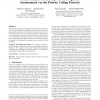118
Voted
CONCUR
2012
Springer
13 years 2 months ago
2012
Springer
Networks of timed automata (NTA) are widely used to model distributed real-time systems. Quite often in the literature, the automata are allowed to share clocks. This is a problem ...
118
Voted
CAV
2012
Springer
13 years 2 months ago
2012
Springer
Real-life systems are usually hard to control, due to their complicated structures, quantitative time factors and even stochastic behaviors. In this work, we present a model checke...
129
click to vote
EMSOFT
2011
Springer
14 years 3 days ago
2011
Springer
As system integration becomes an increasingly important challenge for complex real-time systems, there has been a significant demand for supporting real-time systems in virtualiz...
110
click to vote
DAC
2011
ACM
14 years 5 days ago
2011
ACM
DVFS remains an important energy management technique for embedded systems. However, its negative impact on transient fault rates has been recently shown. In this paper, we propos...
108
click to vote
CASE
2011
14 years 10 days ago
2011
— Legacy systems that do not conform to the norms and regulations imposed by recent safety standards have to be upgraded to meet safety requirements. In this paper, we describe a...
115
Voted
RTS
2011
14 years 3 months ago
2011
This paper is an extended version of a paper that appeared in the proceedings of the IEEE Real-Time Systems Symposium 2009. This paper has been updated with respect to advances ma...
107
click to vote
POPL
2011
ACM
14 years 3 months ago
2011
ACM
We consider programs for embedded real-time systems which use priority-driven preemptive scheduling with task priorities adjusted dynamically according to the immediate ceiling pr...
162
Voted
ISORC
2011
IEEE
14 years 4 months ago
2011
IEEE
—Static cache analysis for data allocated on the heap is practically impossible for standard data caches. We propose a distinct object cache for heap allocated data. The cache is...
RTS
2000
15 years 4 days ago
2000
So far, performance measures for real time systems did not receive much attention. An assessment of the few existing benchmarking methods for real time systems will reveal that the...
111
Voted
IANDC
2007
15 years 9 days ago
2007
We present a model, task automata, for real time systems with non-uniformly recurring computation tasks. It is an extended version of timed automata with asynchronous processes th...

